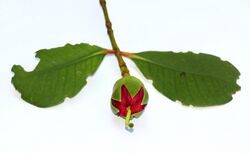Biology:Sonneratia caseolaris
| Sonneratia caseolaris | |
|---|---|

| |
| Unripened mangrove apple | |

| |
| Bud of mangrove apple | |
| Scientific classification | |
| Kingdom: | Plantae |
| Clade: | Tracheophytes |
| Clade: | Angiosperms |
| Clade: | Eudicots |
| Clade: | Rosids |
| Order: | Myrtales |
| Family: | Lythraceae |
| Genus: | Sonneratia |
| Species: | S. caseolaris
|
| Binomial name | |
| Sonneratia caseolaris (L.) Engl.
| |
| Synonyms[2] | |
|
List
| |
Sonneratia caseolaris, commonly known as mangrove apple,[3] is a species of plant in the family Lythraceae. The fruit is noted for its outward similarity to the persimmon fruit.[4]
This tree is a type of mangrove growing up to 20 m in height and with a trunk reaching a maximum diameter of 50 cm. It is present in tropical tidal mud flats from Africa to Indonesia, southwards down to northeast Australia and New Caledonia and northwards up to Hainan Island in China and the Philippines.
The fruit of this tree is the subject of a legend of Maldivian folklore, Kulhlhavah Falhu Rani. Kuhlhavah (ކުއްޅަވައް) is the Dhivehi name for the mangrove apple (Sonneratia caseolaris). [5]
The tree is associated with congregating fireflies throughout southeast Asia[6] and is the food source of moth and other insects.
Uses
The leaves and the fruit are edible and appreciated as food in certain areas, such as Maldives.[3] In Sri Lanka, where the fruit is known as kirala gédi (කිරල ගෙඩි) in Sinhala or Kārk koṭṭaikaḷ (கார்க் கொட்டைகள்) in Tamil, the pulp of the fruit is mixed with coconut milk extract and made into a milk shake.[7] Many tourist resorts situated in the South of Sri Lanka where the trees grow abundantly alongside rivers, offer fresh fruit drinks made from the fruit. In the Maldives the fruits are used as a refreshing drink and also eaten with scraped coconut & sugar.
The tree is also sometimes known as cork tree, because fishermen in some areas make fishing net floats by shaping the pneumatophores into small floats.[6]
References
- ↑ Kathiresan, K.; Salmo III, S.G.; Fernando, E.S.; Peras, J.R.; Sukardjo, S.; Miyagi, T.; Ellison, J.; Koedam, N.E. et al. (2010). "Sonneratia caseolaris". IUCN Red List of Threatened Species 2010: e.T178796A7608551. doi:10.2305/IUCN.UK.2010-2.RLTS.T178796A7608551.en. https://www.iucnredlist.org/species/178796/7608551. Retrieved 19 November 2021.
- ↑ "Sonneratia caseolaris (L.) Engl.". Board of Trustees of the Royal Botanic Gardens, Kew. 2017. http://powo.science.kew.org/taxon/urn:lsid:ipni.org:names:941681-1#synonyms.
- ↑ 3.0 3.1 Mangrove Apple
- ↑ "mangrove flora: berembang (sonneratia caseolaris)". http://mangrove.nus.edu.sg/guidebooks/text/1074.htm.
- ↑ Romero-Frias, Xavier (2012) Folk tales of the Maldives, NIAS Press, ISBN:978-87-7694-104-8, ISBN:978-87-7694-105-5
- ↑ 6.0 6.1 "Berembang (Sonneratia caseolaris) on the Shores of Singapore". http://www.wildsingapore.com/wildfacts/plants/mangrove/sonneratia/caseolaris.htm.
- ↑ Apé Lamā Lōkaya:1950, Chapter 28 (Vijitha Yapa Publications) ISBN:978-955-665-250-5
External links
- Mangrove flora: berembang (Sonneratia caseolaris)
- Flowers of India - Apple Mangrove
- Sonneratia caseolaris
Wikidata ☰ Q4918688 entry
 |



